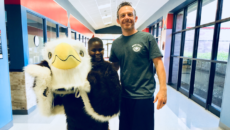“I can’t do my homework tonight. My teacher told me to look at both my parents and decide which one of you gave me my brown eyes and which gave me my red hair. And then I’m supposed to look at Josh and see what traits we have in common. How can I do that?”
“We have a new kid in school from South Korea. My teacher insisted that I be her buddy because I’m Korean. I don’t speak Korean though, so I can’t talk to her. Why was I picked?”
“We’re going to do reports on the countries connected to our family heritage. I told my teacher that your parents were Irish and Dad’s were Polish, but he insists that I do Peru because I’m Peruvian. I don’t want to study Peru; I did a big country report on it last year. Why can’t I study Poland?”
“I have to write an autobiography and my teacher told us to start with our birth and tell where we were born, what time it was, and how our parents felt. I can’t do that. “
These are the challenges of the adopted child at school–the experiences of my own children and those of others I’ve known. Time and again our children face assignments–autobiographies, family trees, family histories, family timelines, and lessons that focus on genetics, heredity, or ethnic origin. These are difficult for them to execute because they require our children to come up with information that is missing, incomplete, or quite different from their peers.
What our kids disclose could be embarrassing or reveal details that we believe should be kept private. If they share the assignment with their classmates, they may also find themselves answering questions about adoption they’re not prepared to answer. Should they then, as some teachers have suggested, “do the best they can,” “just make it up,” or “just use present family relatives?” Those responses in themselves may raise your hackles because they may make your child feel different or ashamed. So can do you do to create adoption awareness in school assignments?
Taking a Proactive Stance
Try to schedule a parent-teacher conference at the beginning of the school year to talk about your child’s needs and any potentially problematic assignments. Don’t assume that the teacher or other school personnel are knowledgeable about adoption or have spent much time thinking about possible curricular pitfalls. Their ignorance is probably not from prejudice or a lack of interest-just a lack of exposure. Chances are your child’s teacher will welcome your sharing general materials about adoption, particularly those that explain how children experience adoption at different ages.
You can also help your child’s teacher by putting adoption into a broader societal perspective: Many family configurations exist in our society today and the feelings of grief and loss that some elementary school children have may be shared by others. Family-oriented assignments prove equally problematic to a foster child, a child of divorced parents, a child living with a stepparent and stepsiblings, the biological child of a single mother, and the child being raised by grandparents. I discussed this with my son’s fifth-grade teacher several years ago after he brought home a complicated chart asking him to interview both his parents about their childhoods, their “first” date, their wedding, favorite music and other likes and dislikes. Seth, I informed the teacher, lived in a traditional nuclear family, but how many of his classmates in this large New York City public school did? How many of them could fill out this rigidly structured chart?
Suggesting Alternatives
“When a parent understands the educational objective of a given assignment, she or he is in a better position to suggest alternatives,” observe Nancy Sheehan Ng and Lansing Wood in Adoption and the Schools. “To use the ubiquitous family tree as an example, kindergarteners might work on family trees to study the basic concept of family. Sixth graders might be assigned a family tree as part of a social studies class. Freshman biology students may be asked to complete a family tree to study genetics and heredity.” Understanding the purpose of a project and exploring alternatives with the teacher, and with your child, is key.
With that in mind, let’s look at some common assignments and how they might be adapted.
Genetics: Rather than focusing a genetics lesson on a youngster’s relationship to his parents and siblings, students could be asked to choose any biologically related group–other family members, friends, neighbors–to investigate inherited traits.
Autobiographies: Life lines entitled When I Was Young, When I Was Younger, and My Life in the Past Year can offer students choices (what they remember about themselves, things their parents have told them about themselves, special toys, rituals, or memorable days). Rather than creating a rigid timeline, the autobiography reveals facets of the child’s personality. Whether it spans the child’s entire life or a shorter time frame doesn’t matter.
Baby Pictures: For assignments that attempt to show how children change over time, a photo of the child at a younger age, rather than in infancy, serves the same purpose. Another alternative is to give children the option of drawing pictures of themselves as babies, so those who do not have photos aren’t made to explain why. If the intention of the assignment is to create a guessing game (such as match the child with the baby photo) and your child is going to be singled out instantly because she’s the only Asian child in the class, the assignment might be broadened to use word clues or favorite things rather than photos for identification.
Country Studies: No child should be compelled to study a particular country because of an assumed link. Children should be able to choose what they wish. My Korean-born daughter happily reported on South Korea when she was in fifth grade. For an immigration report in sixth grade, she could have chosen to write her own story and use her Korean passport as an artifact. Instead, she wrote about her grandmother’s early life Germany and created a fake passport.
Family Trees: What are they trying to show? Are they designed to make linkages between members of a household or a family? Ng and Wood depict many variants: the loving tree (where members of the family are drawn), the caring tree (people who have cared for the child, including physicians, teachers, and foster parents), the rooted tree with roots below and branches above (the present family above and the birth family below), the genealogist’s half wheel (with the child at the center and the birth family on one side of the circle and the adoptive family at the other), the genogram, or a diagram that shows “important people in my life.” In Real Parents, Real Children: Parenting the Adopted Child, authors Holly Van Gulden and Lisa Bartels-Rabb recommend using family houses instead of family trees because people neither grow from trees nor live in them. Regardless of your child’s age or the academic purpose of the assignment, say Van Gulden and Bartels-Rabb, genetic lines are easier to comprehend and represent graphically using houses rather than trees.
Cultural Celebrations: Foreign-born children often are eager to share artifacts of their birth country with the class. This past year, as a high school student, my son brought his Chilean passport with his baby photo and his birth name into his Spanish class so that his classmates could see a real passport in Spanish. (Their textbook had depicted one and they were studying vocabulary connected to applying for a passport.) He was prepared to answer questions about himself. At other times he isn’t anxious to “show and tell” and we’ve respected his decision.
Unique Solutions
Each family’s and child’s solutions may be different. There will be times when your child will be very willing to share information about his adoption or heritage, and others when he just wants to blend in. Talk with your child about how he wants to handle a particular assignment. If he’s uncomfortable adapting it to fit his particular situation, let him do it the way the other kids do. Give him the freedom to make that choice. Beyond looking for adaptations, you can explore with the school how to build their resources. Are there books about foster care and adoption available in the class and school library that the teacher might like to highlight? They might be grouped together permanently or displayed during National Adoption Week. For younger children, how about some videos such as Reading Rainbow’s Through Moon and Stars and Night Skies? You might also provide teachers with some articles or books that discuss adoption and the school. You can also offer to be a resource about adoption for the classroom teacher and the school. Would the school be interested in your giving a presentation to teachers that touches on adoption-related issues? Perhaps your child wants you to come to the classroom to read a favorite book about adoption or help with a cultural celebration? Before you venture into the classroom, however, check with your child about his or her feelings. If your discussion of adoption at school embarrasses him or her, you’ll want to work behind the scenes only.


